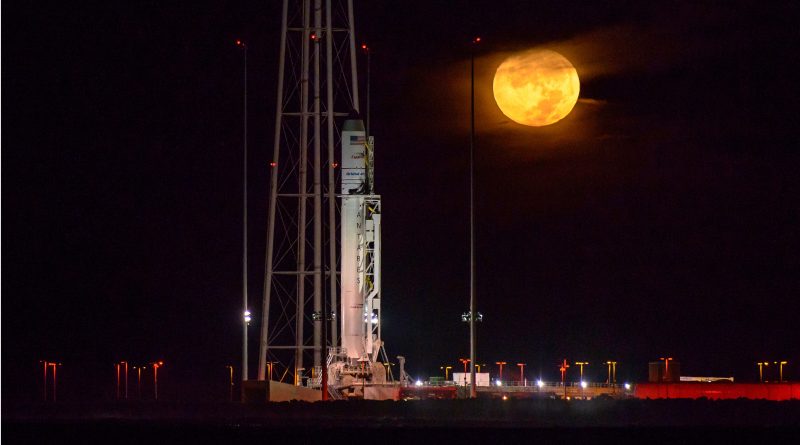Revamped Antares cleared for Sunday Night Launch on ISS Cargo Delivery
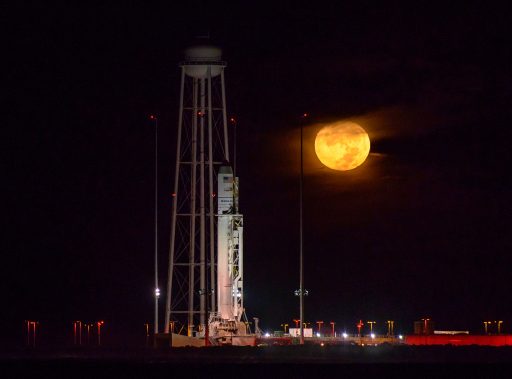
A flight-ready Antares rocket was rolled to Pad 0A at the Mid-Atlantic Regional Spaceport this week for the first time in nearly two years in preparation to restore Orbital ATK’s cargo launch capability to the International Space Station Sunday night.
NASA and Orbital ATK are GO for the Return to Flight mission of the Antares launch vehicle after a long road back from the dramatic October 2014 launch failure with a revamped launch vehicle featuring new engines and a repaired launch facility on Virginia’s East Coast.
The green-light for liftoff was given by NASA on Friday after inspections of a tracking station in Bermuda that had to endure Hurricane Nicole on Thursday but only suffered minor damage and can be operational for a Sunday liftoff. The final clearance for launch was given after a Launch Readiness Review held on Saturday after a final round of testing on the launch pad.
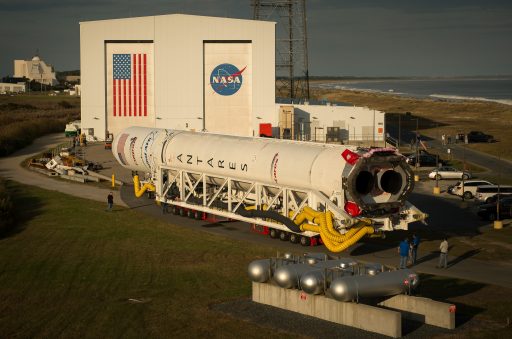
Liftoff aims for 8:03 p.m. local time on Sunday, 0:03 UTC on Monday on a nine-minute climb into orbit to send the 6,200-Kilogram Cygnus spacecraft on a two-day trek to the Space Station for the delivery of 2,350 Kilograms of cargo.
It will be the first launch of the Antares Rocket in combination with the Enhanced Cygnus spacecraft featuring an extended cargo carrier to be able to deliver more supplies to the Space Station. The first two missions of the Enhanced Cygnus were flown by the United Launch Alliance Atlas V rocket to bridge the gap until the Antares 230 launch vehicle was ready for flight.
In the wake of the 2014 failure, Orbital decided to accelerate plans to fit Antares with new engines, stepping away from the AJ26 engines that were only available in limited supply and were identified to be the cause of the dramatic mishap. Now sporting two NPO Energomash RD-181 engines, Antares is expected to be more reliable and can lift more cargo into orbit given the engine’s better performance.
>>Technical Overview: Antares 200 Series
The Launch Pad also had a long road back, going through significant re-build and repair efforts coming at a price tag of $15 million – split evenly between Orbital ATK, NASA and the State of Virginia.
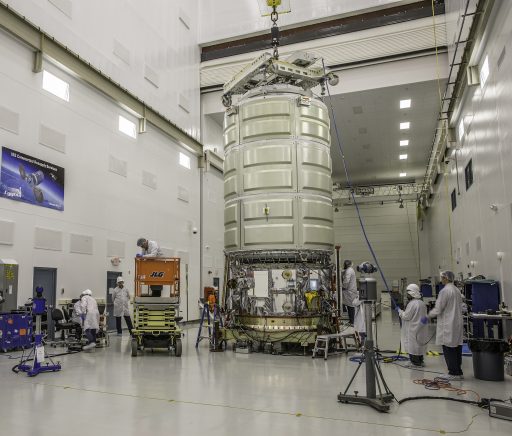
The Cygnus OA-5 mission is an important cargo-delivery to the Space Station as Orbital ATK is currently the only commercial cargo provider that is in a position to lift cargo to ISS. SpaceX is in the midst of a stand-down in launch operations while investigating the September 1 explosion of the company’s Falcon 9 rocket when counting down to what was expected to be a routine Static Fire Test.
Cygnus OA-5, named SS Alan Poindexter in honor of the late NASA Shuttle Pilot & Commander, carries 1,023 Kilograms of maintenance equipment and ISS systems hardware, 585kg of crew supplies including food, 498kg of science equipment, 56kg of computer resources, and 42kg of Russian hardware.
Science investigations aboard Cygnus OA-5 include the second Spacecraft Fire Experiment (SAFFIRE-II) that will be performed aboard the spacecraft after it departs ISS. SAFFIRE is the first study of large-scale fire progression in space to deliver valuable information for the design of future spacecraft since fire represents one of the biggest risk potentials for human spaceflight missions.
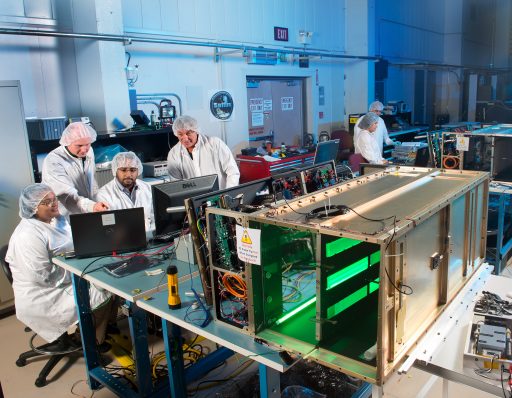
The first SAFFIRE run performed on the OA-6 mission earlier this year used a one-meter long piece of fabric to study large-scale flame spread dynamics. In contrast, SAFFIRE-II features nine smaller samples to examine the flammability of different materials at different thicknesses and their Maximum Oxygen Concentration (MOC) flammability limits.
Another fire study delivered by Cygnus is ‘Cool Flames’ that sets out to explore a phenomenon only recently discovered by combustion studies completed aboard ISS. These studies showed that pure fuels exhibit a two-stage combustion process when burned in small droplets in microgravity characterized by a normal hot-burning stage before extinction of the visible flame and a low-temperature combustion setting in.
Cool Flames delivers to ISS new detector equipment to modify the Station’s Combustion Integrated Rack and then perform a series of experiments with different fuels, atmospheric compositions and additives to improve models of the low-temperature burning process that can be helpful in the development of future spacecraft as well as cleaner-burning engines on Earth.
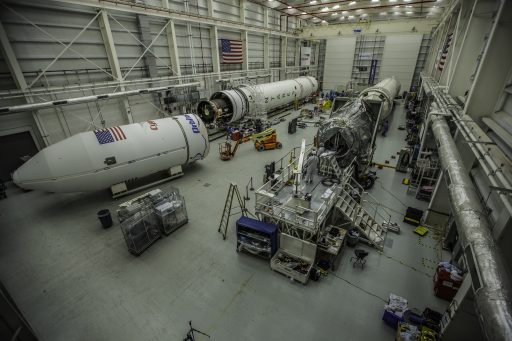
Cygnus also delivers new LED-based lighting fixtures to ISS that will enable the environment aboard the Station to be adjusted to influence the sleep-wake cycles of crew members – a common problem in space with frequent shift changes and busy days.
Following the SpaceX mishap, the cargo manifest for Cygnus was modified to replace ballast mass with crew supplies and upgraded laptops to protect for the event of a longer stand-down by the Falcon 9 rocket.
The Cygnus OA-5 spacecraft was mated to its Antares booster and encapsulated in the protective payload fairing to kick off a busy week at the Mid-Atlantic Regional Spaceport. Antares emerged from its assembly building on Thursday for a slow roll over to Pad 0A at walking pace, taking around one hour to cover one and a half Kilometers to the ‘On-Ramp to ISS’ as prominently shown on a sign at the spaceport pointing to Pad 0A.
The 42.5-meter tall rocket was raised to a vertical launch position on Friday to mark the start of final tests and mission simulations lasting into Saturday to verify all of the launcher’s systems are ready for flight.
Countdown operations will kick off eight hours ahead of the opening of the brief launch window on Sunday. Controllers will report to console to open the Launch Checklist, beginning with a Call to Stations ahead of activation of the Antares launcher for avionics checkouts. In parallel, range equipment will be configured to monitor the Wallops Range for the remainder of the Countdown.
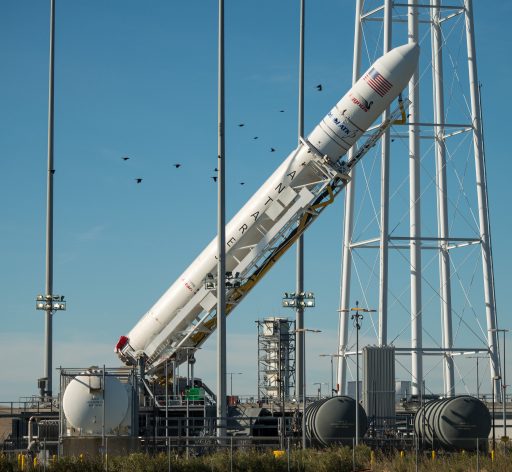
Teams will depart the pad around six hours ahead of launch after buttoning up all launch vehicle and ground systems at Pad 0A – a Red Team will be available to access the pad in case any last minute reconfigurations are needed.
The launch vehicle is activated at L-5 hours to begin a Combined Systems Test with the Cygnus spacecraft that verifies that all systems on the vehicles can communicate and function as advertised. Testing includes C- and S-Band Communication Checks, Telemetry Verifications, Cygnus Systems Checks, a final Mission Simulation Test and Flight Termination System verifications.
After activation of the Propellant Loading Sequencer, pad systems will enter conditioning for propellant loading – being pressurized and chilled down before the first stage of the two-stage rocket will head into oxidizer tank chilldown. The Yuzhmash-built first stage will be loaded with over 170 metric tons of liquid oxygen and nearly 65 tons of Rocket Propellant-1, being filled through interfaces located in the launch mount at the base of the rocket.
Only the 27.6-meter long first stage of the Antares rocket has to be loaded during Sunday’s countdown – the second stage is a Castor 30XL Solid Rocket Motor that will be tasked with giving Cygnus the final push into orbit.
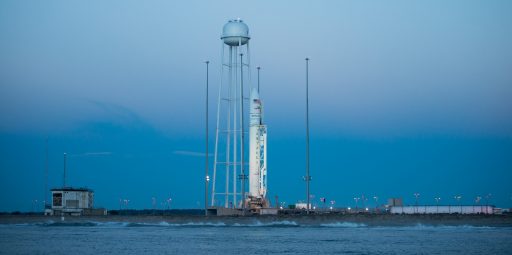
Flight software load and final checkouts commence inside L-1 hour, working towards a Go/No Go Poll as clocks tick down to L-10 minutes. At that point the launcher will perform final reconfigurations and Cygnus will be switched to internal power and transition to flight mode.
At T-5 Minutes, the Flight Termination System and Antares Launcher are switched to internal power. Starting at T-3 minutes and 30 seconds, the countdown will enter its automated phase that is controlled by the Auto Sequencer and involves final reconfigurations of Antares to put it in its launch configuration, notably the pressurization of tanks, the handover of control authority, transfer to internal power & arming of the termination system.
The twin RD-181 engines will rumble to life by injecting liquid oxygen and ignition fluid into the gas generators and combustion chambers to begin driving the turbopumps and initiate combustion to reach a liftoff thrust of 392 metric-ton force, creating an initial thrust to weight ratio of 1.3 compared to 1.16 for the previous iteration of the Antares rocket.
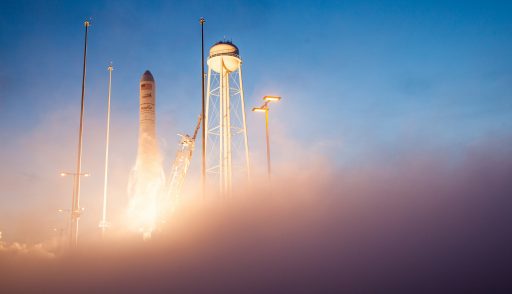
Immediately after lifting off, the two engines will gimbal to move the tail end of the rocket away from the Transporter-Erector-Launcher that will retract at the moment of liftoff. Completing a pitch and roll maneuver, Antares will swing to the south-east putting on a spectacular show in the skies over Virginia and neighboring states.
Antares will pass the speed of sound around one minute into the flight followed a few seconds later by Maximum Dynamic Pressure, flying a pre-programmed attitude profile.
Because of the higher performance and flow rates of the new engines, Antares will have a shorter first stage burn time compared to the 100 Series, shutting down around three minutes and 35 seconds into the flight. The 3.9-meter diameter core stage is jettisoned 15 seconds after shutdown, marking the start of a passive coast phase to allow the vehicle to climb uphill so that the second stage burn can raise the perigee to orbital altitude.
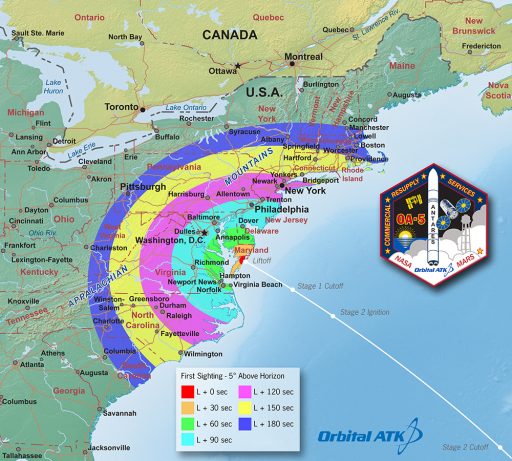
Just before ignition of the Castor 30XL, Cygnus will be revealed when the two ten-meter fairing halves will be split open and drop away as aerodynamic forces are no longer a factor outside Earth’s dense atmospheric layers. The 1-2 Interstage Adapter is also jettisoned while the vehicle is in coast flight to shed unnecessary weight ahead of the upper stage burn.
Ignition of the Castor 30XL occurs approximately 140 Kilometers in altitude to give Cygnus the final push to reach orbit. Castor 30XL provides an average thrust of over 300 Kilonewtons over the course of its 2-minute 38-second burn with a peak thrust level at 396kN. The second stage uses energy management to precisely inject the payload into its desired orbit and correct any errors that occurred during first stage flight.
Previous Cygnus missions targeted a 200 by 300-Kilometer insertion orbit inclined 51.6 degrees from where the spacecraft will use its BT-4 main engine to link up with the Space Station in its nearly circular orbit at 400 Kilometers.
Following burnout of the second stage, the vehicle will again coast in order to allow residual thrust to tail off on the solid rocket motor to ensure a clean spacecraft separation. A cold gas thruster system provides attitude control during the passive flight phase and orients the stack for the separation of the payload.
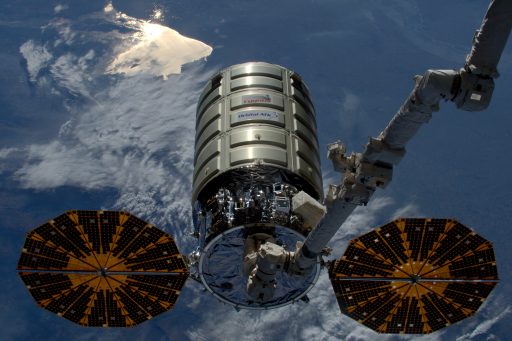
Sent on its way some nine minutes after launch, Cygnus will establish a stable three-axis orientation and initiate communications through the Tracking and Data Relay Satellite System. The critical deployment of the spacecraft’s two circular UltraFlex solar arrays is expected to commence 90 minutes into the flight and will take around 15 minutes before teams will be able to confirm they have a power-positive spacecraft ready for the climb to the Space Station.
Cygnus will spend two and a half days conducting a series of orbit-raising and phasing maneuvers to enter its approach to ISS, closing in from behind and below to initiate its rendezvous in the early hours on Wednesday. The rendezvous includes a series of propulsive maneuvers to put Cygnus on a path to reach a position directly below ISS from where it will ascend vertically to come to a halt at its capture point.
NASA Astronaut Kate Rubins and JAXA crew member Takuya Onishi will be inside the Cupola of the Space Station driving the robotic arm for the capture expected at 11:20 UTC on Wednesday to mark the start of a month-long stay at the Space Station.

